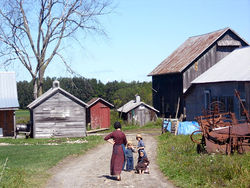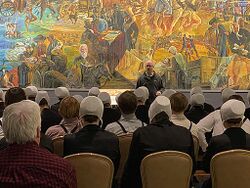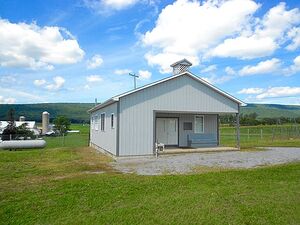Amish
 From Conservapedia
From Conservapedia 
The Amish are an Anabaptist Christian denomination and part of the Mennonite sect best known for rejecting many modern conveniences such as electricity and automobiles, while adhering to an agrarian lifestyle. They dress plainly (a compliment is "You look plain") and live apart from mainstream society while strictly observing the Lord's Day (Sunday) as a day of rest. There are Amish communities in 32 out of the 50 United States, in 2022, while rapidly growing and expanding into additional states. "The Amish are one of the fastest-growing population groups in America," and their population "has more than tripled" in just three decades.[1]
The Amish are a leaders in establishing rights of religious liberty, mentioned in more than about 1,000 court cases as of Jan. 23, 2022 (roughly half federal and half in state court). Most of the cases concern challenges to regulations of their farms, but some implicate the Second Amendment and other rights. One example was an unsuccessful motion to dismiss a federal indictment in Pennsylvania of an Amish man for allegedly "dealing in firearms without a license ... in violation of the Gun Control Act, specifically, title 18, United States Code, Section 922(a)(1)(A) and 924(a)(1)(D)." United States v. King, No. 5:22-cr-00215-001, 2022 U.S. Dist. LEXIS 224929, at *1 (E.D. Pa. Dec. 14, 2022)
Amish live "off-the-grid" without use of electricity, which liberals ostensibly prefer yet hypocritically rarely do themselves, and even impose regulations making it difficult to live this way. Amish do not participate in Social Security (they obtained an exemption due to their religious beliefs) and also generally do not attend school beyond 8th grade but continue to learn by reading throughout their lives. Their ancestors were German-speaking Swiss who arrived in eastern Pennsylvania in the 1700s, and more came over in the 1800s. The now-largest Amish settlement (148 large families today) west of the Mississippi River was from Switzerland to Kolona in southeastern Iowa, in 1846.[2] Many Amish people speak Pennsylvania Dutch, a dialect of German.
The Amish are the fastest growing religion in the United States, doubling every 20 years.[3] The Amish population is growing so fast that each year some families move out to acquire more farmland. They are highly successful financially and morally. By 2050 the Amish are expected to attain 1 million in total population in the United States, and by 2222 the Amish could be the majority in the U.S.[4] The largest Amish communities are in Pennsylvania, where the Amish population exceeded 84,000 as of 2021 and is growing at more than 3% annual rate.
The hit movie "Witness" (1985) is a highly accurate, respectful portrayal of the Amish that was filmed on location in the Philadelphia area.
There are different sects of Amish, such as the "Old Order Amish" and the "New Order Amish." In some ways the New Order is more conservative than the Old Order, as the New Order completely bans alcohol and smoking. Within the Old Order Amish are the Swartzentruber Amish, who are particularly conservative.
The largest Amish communities are in Pennsylvania. Statewide, Ohio and Indiana also have high Amish populations.[5] An Amish rule is that "one should buy no more land than he can work,"[2] such as 80 acres for one large family. On that property crops of corn, hay, and oats can be grown to support 30 cows and 60 hogs.
The group was founded by Jakob Ammann in the 1690s and began to settle in Ohio, Pennsylvania, and Indiana beginning in the 18th century.[6] "The Scribbler counted the number of directory pages devoted to each Amish surname. Stoltzfus came in first, by far, followed by King, Fisher, Beiler, Esh, and Lapp."[7] Hochstetler, Hochleitner, and Yoder are also common Amish surnames.
Many Amish have large families and in 2012 the Amish were named the fastest growing faith group in the United States. The Amish population is projected to grow to 1 million people by 2050.[8]
No cases of the coronavirus were reported among Amish in 2020 during the CCP global pandemic.
Contents
- 1 Expansion
- 2 Full Sabbath Observance
- 3 Exempt from Social Security
- 4 Declining all Government Handouts
- 5 Exempt from Public School
- 6 Low rate of autism among the Amish
- 7 Politics
- 8 Conversion to Amish
- 9 Travel
- 10 Language
- 11 No Photographs
- 12 References
- 13 See also
Expansion[edit]
As the Amish population rapidly increases, each settlement is generally limited to about 40 families. When they grow larger than that, as they often do, then new land is acquired and a new settlement is formed. Because Amish do not use electricity, all they really need is a well.[9] Many unproductive small farms are being turned into productive uses by expanding Amish families who settle there.
Full Sabbath Observance[edit]

Amish fully enjoy the weekly Sabbath as a complete day of rest and relaxation. All non-necessary work is avoided for the entire day. Commentators have particularly praised this aspect of Amish life.[10]
The Amish do not watch television, so there is no addiction to the NFL that disrupts the Sabbath and Christmas Day as it does for millions of Americans.
Exempt from Social Security[edit]
The Amish asserted a religious exemption to any participation in Social Security as being against the tenets of their religion. The Amish lost their appeal on this issue in the unanimous U.S. Supreme Court decision of United States v. Lee, 455 U.S. 252 (1982), But then Congress created a narrow exception for Amish-owned businesses and businesses owned by similar members of religions having well-established objections to Social Security, which enables them to opt out of the obligations and benefits of the program. A special form must be filed by the Amish to assert this exemption.
Congressman Gibbs (R-OH), who had Amish constituents, introduced federal legislation in 2021 to broaden rights of the Amish.[11]
The Amish do not accept any Social Security, unemployment, or welfare checks from the government.
Declining all Government Handouts[edit]
The Amish refuse to accept any handouts or funds from any government. Some have attempted to find private funding for environmentalist programs for Amish communities.
Exempt from Public School[edit]
The U.S. Supreme Court established an exemption from compulsory attendance at school for the Amish, specifically the Old Order Amish Mennonite Church, in Wisconsin v. Yoder (May 15, 1972) (7-0 ruling), based on their First Amendment right to free exercise of religion.

Low rate of autism among the Amish[edit]

See also: Atheism and autism
The American Amish have low autism rates which may be due to their low vaccination rates. They also tend to have a healthy and simple lifestyle.[12] Due to their high levels of physical activity, the Amish have low rates of obesity.[13]
David N. Brown indicated: "In March 2006, Drs. Kevin Strauss, Holmes Morton and others documented 9 autistic Amish children, which could raise the autism rate of the Lancaster Amish community Olmsted supposedly investigated to almost 1/5,000 which is still a fraction of the US average of 1/68."[14][15][16]]
Politics[edit]
Conservative themselves, Amish tend to support conservative candidates, and overwhelmingly supported Donald Trump in 2016.[17] But only about 5% of Amish actually vote in elections.[17]
Conversion to Amish[edit]
Through a process known as conversion and commitment, anyone can become Amish.[18] But there is no evangelical movement by Amish to initiate that, so it is rare.
Travel[edit]
Contrary to secular perception, Amish are allowed to travel by train, and be passengers in cars. But they are not allowed to travel by air or drive cars, which are viewed as non-essential luxuries.[19]
Language[edit]
Amish are fluent in English, but typically speak a dialect of German known as "Pennsylvania German," or "Pennsylvania Dutch" where "Dutch" is a misnomer for "Deutsche" (German).[20] Ethnically, Amish are of Swiss descent and not German or Dutch.
No Photographs[edit]
Amish prohibit taking any photos of them, in strict compliance with the prohibition in the Bible against carved images, see Exodus 20:4 .[21] Tourists trying to take pictures of them against their beliefs is perhaps their greatest frustration with tourism.
References[edit]
- ↑ https://www.usatoday.com/story/news/nation/2014/08/15/amish-ten-things-you-need-to-know/14111249/
- ↑ 2.0 2.1 https://www.chicagotribune.com/news/ct-xpm-1988-08-09-8801210505-story.html
- ↑ https://www.bloomberg.com/news/articles/2012-08-01/why-the-amish-population-is-exploding#:~:text=But according to a new,in 1989 of about 100,000.
- ↑ By doubling its population every 20 years, the Amish population would increase by 1024 times in 200 years.
- ↑ https://www.incontext.indiana.edu/2012/nov-dec/article2.asp
- ↑ The New American Desk Encyclopedia, Penguin Group, 1989
- ↑ https://lancasteronline.com/news/local/there-are-4-books-every-old-order-amish-family-keeps-in-its-home-collection-the/article_5a448cc2-9a8d-11e8-a2ea-1fc6bc69d5d9.htm
- ↑ For Amish, fastest-growing faith group in US, life is changing
- ↑ https://www.minnpost.com/greater-minnesota/2021/07/amish-paradise-the-traditionalist-christian-groups-population-has-been-growing-in-minnesota-a-lot/
- ↑ https://amishamerica.com/how-do-amish-keep-the-sabbath-holy/
- ↑ https://gibbs.house.gov/2021/12/gibbs-introduces-legislation-amish-community-regulatory-relief
- ↑
- 4 healthy habits to steal from the Amish, Fox News Health, December 04, 2014
- "Amish Have Lower Rates of Cancer, Ohio State Study Shows". Columbus, OH: Ohio State University Medical Center. January 1, 2010. Retrieved January 6, 2010.
- Puffenberger, EG; Jinks, RN; Wang, H; Xin, B; Fiorentini, C; Sherman, EA; Degrazio, D; Shaw, C; Sougnez, C; Cibulskis, K; Gabriel, S; Kelley, RI; Morton, DH; Strauss, KA (Dec 2012). "A homozygous missense mutation in HERC2 associated with global developmental delay and autism spectrum disorder". Human Mutation 33 (12): 1639–1646
- Jackman, C; Horn, ND; Molleston, JP; Sokol, DK (Apr 2009). "Gene associated with seizures, autism, and hepatomegaly in an Amish girl". Pediatric Neurology 40 (4): 310–313.
- Alarcón, Maricela; Abrahams, Brett S.; Stone, Jennifer L.; Duvall, Jacqueline A.; Perederiy, Julia V.; Bomar, Jamee M.; Sebat, Jonathan; Wigler, Michael; Martin, Christa L.; Ledbetter, David H.; Nelson, Stanley F.; Cantor, Rita M.; Geschwind, Daniel H. (10 January 2008). "Linkage, Association, and Gene-Expression Analyses Identify CNTNAP2 as an Autism-Susceptibility Gene". American Journal of Human Genetics 82 (1): 150–159
- ↑
- 4 healthy habits to steal from the Amish, Fox News Health, December 04, 2014
- ↑ Puffenberger, EG; Jinks, RN; Wang, H; Xin, B; Fiorentini, C; Sherman, EA; Degrazio, D; Shaw, C; Sougnez, C; Cibulskis, K; Gabriel, S; Kelley, RI; Morton, DH; Strauss, KA (Dec 2012). "A homozygous missense mutation in HERC2 associated with global developmental delay and autism spectrum disorder". Human Mutation 33 (12): 1639–1646
- ↑ Jackman, C; Horn, ND; Molleston, JP; Sokol, DK (Apr 2009). "Gene associated with seizures, autism, and hepatomegaly in an Amish girl". Pediatric Neurology 40 (4): 310–313.
- ↑ Alarcón, Maricela; Abrahams, Brett S.; Stone, Jennifer L.; Duvall, Jacqueline A.; Perederiy, Julia V.; Bomar, Jamee M.; Sebat, Jonathan; Wigler, Michael; Martin, Christa L.; Ledbetter, David H.; Nelson, Stanley F.; Cantor, Rita M.; Geschwind, Daniel H. (10 January 2008). "Linkage, Association, and Gene-Expression Analyses Identify CNTNAP2 as an Autism-Susceptibility Gene". American Journal of Human Genetics 82 (1): 150–159
- ↑ 17.0 17.1 https://www.nationalobserver.com/2016/08/07/news/how-amish-see-donald-trump-otherworldly-candidate-theyve-never-heard-speak
- ↑ https://lancasterpa.com/amish/amish-frequently-asked-questions/
- ↑ https://amishamerica.com/how-do-amish-travel/
- ↑ https://www.dutchcrafters.com/blog/pennsylvania-dutch-the-amish-language/
- ↑ https://www.discoverlancaster.com/amish/lifestyle/
See also[edit]
- Summary of History and Persecution
- Mennonite
- Infant baptism
- Essay: Water baptism cannot save, the Church cannot save, Born again by faith alone
- 10 reasons why the Amish are healthy
Categories: [Amish] [Christian Denominations]
↧ Download as ZWI file | Last modified: 02/26/2023 15:37:24 | 122 views
☰ Source: https://www.conservapedia.com/Amish | License: CC BY-SA 3.0
 ZWI signed:
ZWI signed: KSF
KSF